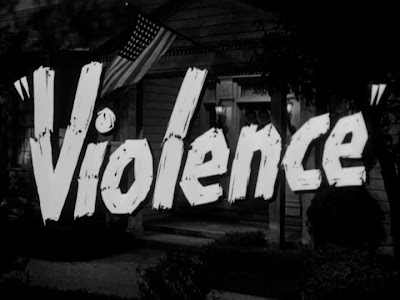Violence
 On paper, Violence (Monogram, Jack Bernhard) sounds like it retreads many of the thematic concerns of social problem films/noirs/films gris of the period: veterans returning to civilian life, political corruption, and amnesia. It is topically about the postwar moment - which direction America is going to take politically after the War's end. The plot centers on a fascist political movement bankrolled by a mysterious business interest but posing as a populist organization helping out veterans and fronted by a charismatic sermonizing speaker named True Dawson.
On paper, Violence (Monogram, Jack Bernhard) sounds like it retreads many of the thematic concerns of social problem films/noirs/films gris of the period: veterans returning to civilian life, political corruption, and amnesia. It is topically about the postwar moment - which direction America is going to take politically after the War's end. The plot centers on a fascist political movement bankrolled by a mysterious business interest but posing as a populist organization helping out veterans and fronted by a charismatic sermonizing speaker named True Dawson.
What's distinctive is that the elements do not line up in a way typical to noir or the social problem film. Amnesia does not induce flashbacks, create narrative enigma, suggest an unknowable femme fatale, or allegorize America's war experience. Rather, the plot device dramatizes political brainwashing and the specific politics of the left's encounter with the right in the Truman years.
 In this way the film is a narrow product of its times - not only would leftism retrench in America, but also the postwar liberal consensus would make the idea of a fascist takeover of US politics seem a little paranoid. But its paranoia was prescient, and Violence seems to cover some of the 1970s conspiracy thriller territory years ahead of its time. Meanwhile, the casting of ideological positions as crime melodrama makes the film seem closer in spirit to Warner Brothers' 1930 problem film or "headliner" cycle than the postwar liberalism of the 1940s social problem film.
In this way the film is a narrow product of its times - not only would leftism retrench in America, but also the postwar liberal consensus would make the idea of a fascist takeover of US politics seem a little paranoid. But its paranoia was prescient, and Violence seems to cover some of the 1970s conspiracy thriller territory years ahead of its time. Meanwhile, the casting of ideological positions as crime melodrama makes the film seem closer in spirit to Warner Brothers' 1930 problem film or "headliner" cycle than the postwar liberalism of the 1940s social problem film.
It is here, again, I wonder how much sense it makes to label this a film noir. Yes, it has a raw, Poverty Row aesthetic and a cynical critique of American society. And it is a crime film shot in low-key black-and-white. But its visual style, its narrative form, and its thematics lack the kind of pulp modernism that I would see as essentially to noir.
That said, Violence is an excellent example of the Poverty Row/B-film approach to lighting, which tries to punch above its weight, budgetarily speaking, by simply not caring about cast shadows. Many B and A noirs would take some of the same attitude (see the lighting in Born to Kill for instance).


Comments